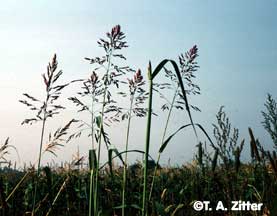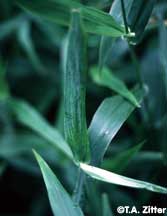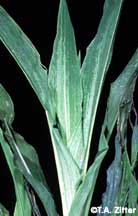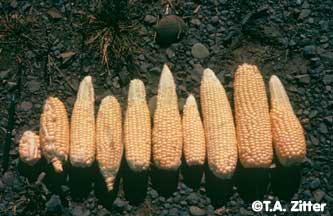Maize dwarf mosaic potyvirus
Virus description — MDMV is a member of the potyvirus group, which represents the main vegetable-infecting group of viruses. The virus is transmitted in a nonpersistent (stylet-borne) manner by several aphid species. The virus is acquired in less than 60 sec., transmitted in less than 60 sec., but is not retained by the aphid for any length of time (usually less than 1 hr.). An aphid must revisit an already infected corn plant or a perennial grass reservoir to reacquire the virus.MDMV has not been a factor for corn production in the state for 15 or more years. Natural hosts have included field and sweet corn, grain sorghum, Johnsongrass (Fig. 4) (which is not important in New York), and various perennial weeds like deer’s-tongue (Panicum clandestinum) (Fig. 5), commonly found in the Hudson Valley. Interestingly, cultivated wheat, barley, oat and rye are not susceptible. Five strains of MDMV are recognized, with strain A considered as the type strain. MDMV strain B is now classified as a strain of sugarcane mosaic virus. MDMV is seed-transmitted in dent corn at very low frequencies (0.007 to 0.4%).
| Figures 4 and 5. Hosts of maize dwarf mosaic virus include Johnsongrass(Sorghum halepense) Left and deer's-tongue (Panicum clandestinum)(Right). Photos cortesy of T. A. Zitter | |
 |  |
Aphid vectors — At least 15 species can transmit MDMV, including the greenbug (Schizaphis graminum), the English grain aphid (Sitobion [Macrosiphum] avenae), the oat bird cherry aphid (Rhopalosiphum padi), and the corn leaf aphid (Rhopalosiphum maidis). Many factors can influence the frequency of transmission by aphids.
Management guidelines — MDMV occurred in at least three areas of the state last season (Hudson Valley, Capital District, and western New York), but we can only speculate on reasons for its occurrence in 2000. Movement of viruliferous aphids into corn has been previously noted, and with the heavy occurrence of common rust this last year, air movement of rust and aphids is possible. The chance for seed transmission is very remote, and would not explain the occurrence over such a wide area, with such a wide divergence in variety selections. Although sweet corn varieties change frequently, we are unaware if some varieties are more susceptible than those grown in past seasons.
The management of MDMV is very difficult because of the nonpersistent manner of spread. Insecticides can reduce aphid populations, but do not prevent virus transmission, and at best would only slow the rate of virus spread.
source :
Date 5-2001
COOPERATIVE
EXTENSION • NEW YORK STATE • CORNELL UNIVERSITY
by Thomas A. Zitter, Department of Plant Pathology,
Cornell University, Ithaca, New York 14853
Cornell University, Ithaca, New York 14853


Tidak ada komentar:
Posting Komentar
SERVE BETTER YOU